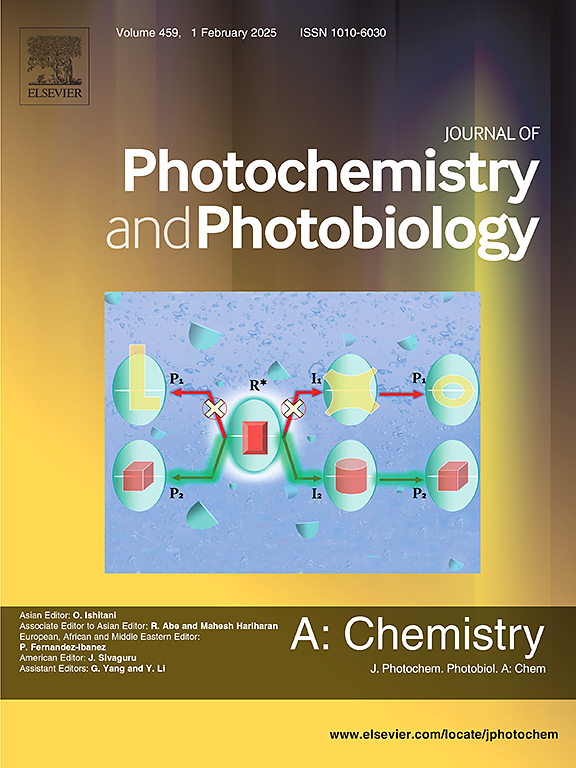Enhancing Mn4+ luminescence via Y3+ substitution in Sr0.1La0.9Mg0.45Ti0.55O3 double perovskite for advanced horticultural lighting
IF 4.7
3区 化学
Q2 CHEMISTRY, PHYSICAL
Journal of Photochemistry and Photobiology A-chemistry
Pub Date : 2025-07-25
DOI:10.1016/j.jphotochem.2025.116648
引用次数: 0
Abstract
Far-red-emitting phosphors play a pivotal role in horticultural light-emitting diodes (LEDs), as red light is critical for photosynthesis and photomorphogenic regulation in plants. Here, we report the synthesis of a novel series of Mn4+-doped double-perovskite Sr0.1La0.9Mg0.45Ti0.55O3 (SLMTO) phosphors via conventional high-temperature solid-state reactions. The phase purity was confirmed by X-ray powder diffraction (XRD), and energy-dispersive X-ray spectroscopy (EDS) confirmed the successful incorporation of Mn4+ ions into the host lattice. Under 365 nm excitation, SLMTO: Mn4+ phosphor exhibits a sharp far-red emission at 709 nm, corresponding to the 2E1g → 4A2g transition. Photoluminescence excitation monitored at 709 nm reveals broad band from 200 to 600 nm, indicating effective ultraviolet-visible excitation. Tanabe-Sugano diagram analysis reveals that Mn4+ ions occupies octahedral sites under a strong crystal field. Further investigations elucidate the crystal field effects, concentration quenching mechanism, and thermal quenching behavior of Mn4+ ions in the SLMTO host. To boost emission intensity, partial A-site substitution with Y3+ was performed, the Y3+-doped phosphor achieves an internal quantum efficiency (IQE) of 89.2 %, an activation energy of 0.375 eV, and a color purity of 95.8 %. Notably, the emission profile of the optimized phosphor closely overlaps the far-red absorption band of plant phytochrome far-red light (Pfr). And a far-red light-emitting diode (LED) device by combining the phosphor with a 365 nm LED chip was fabricated, the resulting device demonstrates great potential for plant growth lighting applications.

用Y3+取代Sr0.1La0.9Mg0.45Ti0.55O3双钙钛矿增强Mn4+发光用于高级园艺照明
远红色发光荧光粉在园艺发光二极管(led)中起着关键作用,因为红光对植物的光合作用和光形态形成调控至关重要。本文报道了一种新型的Mn4+掺杂双钙钛矿Sr0.1La0.9Mg0.45Ti0.55O3 (SLMTO)荧光粉的合成方法。通过x射线粉末衍射(XRD)和能谱分析(EDS)证实了Mn4+离子成功进入基体晶格。在365 nm激发下,SLMTO: Mn4+荧光粉在709 nm处表现出明显的远红发射,对应于2E1g→4A2g跃迁。在709 nm处监测的光致发光激发显示出200 ~ 600 nm的宽波段,表明有效的紫外可见激发。Tanabe-Sugano图分析表明,在强晶体场作用下,Mn4+离子占据八面体位。进一步的研究阐明了Mn4+离子在SLMTO基体中的晶体场效应、浓度猝灭机制和热猝灭行为。为了提高发射强度,用Y3+进行部分a位取代,Y3+掺杂荧光粉的内量子效率(IQE)为89.2%,活化能为0.375 eV,色纯度为95.8%。值得注意的是,优化后的荧光粉的发射谱线与植物光敏色素远红光(Pfr)的远红光吸收带紧密重叠。并将该荧光粉与365 nm的LED芯片相结合制成了远红色发光二极管(LED)器件,该器件在植物生长照明方面具有很大的应用潜力。
本文章由计算机程序翻译,如有差异,请以英文原文为准。
求助全文
约1分钟内获得全文
求助全文
来源期刊
CiteScore
7.90
自引率
7.00%
发文量
580
审稿时长
48 days
期刊介绍:
JPPA publishes the results of fundamental studies on all aspects of chemical phenomena induced by interactions between light and molecules/matter of all kinds.
All systems capable of being described at the molecular or integrated multimolecular level are appropriate for the journal. This includes all molecular chemical species as well as biomolecular, supramolecular, polymer and other macromolecular systems, as well as solid state photochemistry. In addition, the journal publishes studies of semiconductor and other photoactive organic and inorganic materials, photocatalysis (organic, inorganic, supramolecular and superconductor).
The scope includes condensed and gas phase photochemistry, as well as synchrotron radiation chemistry. A broad range of processes and techniques in photochemistry are covered such as light induced energy, electron and proton transfer; nonlinear photochemical behavior; mechanistic investigation of photochemical reactions and identification of the products of photochemical reactions; quantum yield determinations and measurements of rate constants for primary and secondary photochemical processes; steady-state and time-resolved emission, ultrafast spectroscopic methods, single molecule spectroscopy, time resolved X-ray diffraction, luminescence microscopy, and scattering spectroscopy applied to photochemistry. Papers in emerging and applied areas such as luminescent sensors, electroluminescence, solar energy conversion, atmospheric photochemistry, environmental remediation, and related photocatalytic chemistry are also welcome.

 求助内容:
求助内容: 应助结果提醒方式:
应助结果提醒方式:


